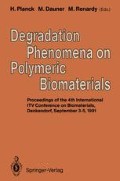Abstract
Until now we don’t really know how much stability is needed for undisturbed bone healing. Usual metal fixation in fracture treatment is without any doubt a successful procedure. Cortical bone and steel are very different materials, especially concerning the elastic properties. The elasticity constant of bone is only 1/10 of implant steel, and tensile strength is 10 times lower. In the months following internal fixation, bone substance is decreasing as a matter of deviation of force over the implant. The removal of metal implants is followed by a period of weakened bone (stress protection) with the danger of refractture or second fracture. Bone healing is a dynamic procedure, starting with no stability at all up to regulär strength. The idea of biodegradable implants depends on the reflected image of the bone, that means a decreasing weightbearing of the material. After months, the whole material has disappeared completely and no secondary surgery is needed. Besides the costs, time of treatment and uncomfort of the patient descends. Polymer materials which are hopeful for this indication are Polyglycolide, Polylactide, Polydioxanone and Polyhydroxy- butyrate. The physical data are well known and do not differ fundamentally. They can be improved by higher molecular weight and various kinds of treatment after polymerisation. Copolymers are investigated as well as Compound materials. Because we need a complete system for internal fixation, the development of biodegradable implants has five aims: the replacement material for K-wires, flexible wires, cords, plates and screws.
Access this chapter
Tax calculation will be finalised at checkout
Purchases are for personal use only
Preview
Unable to display preview. Download preview PDF.
References
Dociu, N., P. Hein: PDS - ein neues chirurgisches Nahtmaterial Ethicon OP-Forum (1981) 108
Keller, H.W., K.E. Rehm: Die Versorgung der kompletten Schultereckgelenkssprengung ohne metallisches Implantat Unfallchirurg 94 (1991) 511–513
Rehm, K.E.: Die geschlossene Kreuzbandplastik Unfallchirurgie 7 No. 2 (1981) 55–59
Rehm, K.E., K.H. Schultheis, P. Bopp, H. Ecke: Biomechanische Untersuchungen vom resorbierbaren Bandersatz und deren klinische Bedeutung Langenbecks Arch. Chir. Suppl. (1984) 207–211
Rehm, K.E., B. Kaletsch: Mikrogefässanastomosen mit resorbierbarem oder nicht resorbierbarem Nahtmaterial in: Biomaterialien und Nahtmaterial, S. 298–302 Hrsg.: H. Rettig Springer Verlag, Berlin - Heidelberg 1984
Rehm, K.E.: Versorgung der Schultereckgelenkssprengung ohne metallisches Implantat in: Biomechanik der gesunden und kranken Schulter, S. 47–48 Hrsg. H.J. Refior, W. Plitz, M. Jäger u. M. Hackenbroch Thieme Verlag, Stuttgart - New York 1985
Rehm, K.E., K.H. Schultheis: Bandersatz mit Polydioxanon (PDS) Unfallchirurgie 5 (1985) 264–273
Rehm, K.E.: Biodegradable implants in Traumatology and Reconstructive Surgery: Stage of development and clinical significance Polymery W Medycynie PWN-Polish Scientific Publishers T XVIII No. 3 (1988) 117
Rehm, K.E.: Entwicklungsstand und klinische Bedeutung von resorbierbaren Osteosynthesematerialien Hefte zur Unfallheilkunde 200 (1988) 663
Rehm, K.E., H.J. Helling, L. Claes: Biologisch abbaubare Osteosynthesematerialien in: Jahrbuch der Chirurgie (1989) S. 223–232 Biermann Verlag, Zülpich 1989
Rehm, K.E.: Biodegradable Implants in Traumatology and Reconstructive Surgery Chemia Stosowana 34, No. 1-2 (1990), 41–48
Rehm, K.E.: Kreuzbandaugmentationsplastik mit Patellarsehne und PDS- Kordel Serie “Im Dienste der Chirurgie” 72 Ethicon, Hamburg (1990)
Zieren, H.U., W.A. Holzmüller, J. Rosenberger, K.E. Rehm Sind Patellazuggurtungen mit resorbierbaren Materialien möglich? Unfallchirurg 94 (1991) 634–639
Author information
Authors and Affiliations
Editor information
Editors and Affiliations
Rights and permissions
Copyright information
© 1992 Springer-Verlag Berlin Heidelberg
About this paper
Cite this paper
Rehm, K.E. (1992). Clinical Application of Resorbable Biomaterials in Reconstructive Surgery. In: Planck, H., Dauner, M., Renardy, M. (eds) Degradation Phenomena on Polymeric Biomaterials. Springer, Berlin, Heidelberg. https://doi.org/10.1007/978-3-642-77563-5_13
Download citation
DOI: https://doi.org/10.1007/978-3-642-77563-5_13
Publisher Name: Springer, Berlin, Heidelberg
Print ISBN: 978-3-642-77565-9
Online ISBN: 978-3-642-77563-5
eBook Packages: Springer Book Archive

